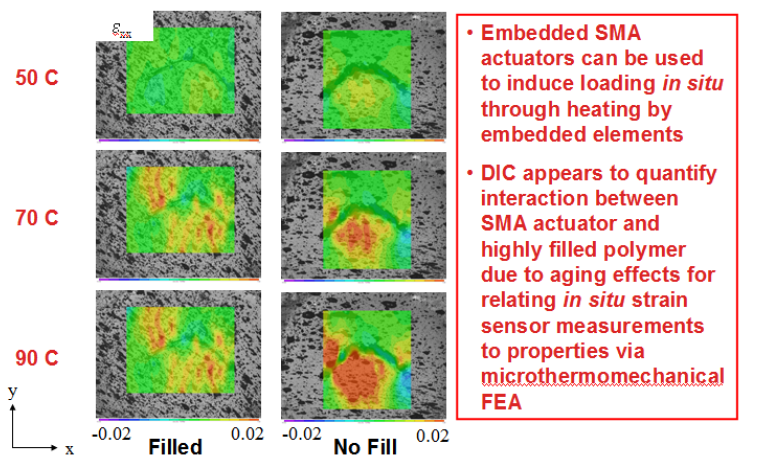![]() Health Management of Energetics
Health Management of Energetics
PI: Prof. Hugh Bruck
The motivation for this research is to develop a new technique for characterizing mechanical properties of highly-filled polymers (i.e., composites with high volume fractions of solids fill like propellants) in situ (i.e., inside of the material). The basic concept we have developed is as follows:
- Place a piece of Shape Memory Alloy (SMA), as an active element which is capable of recovering large amounts of plastic deformation upon heating, inside of the highly-filled polymer to act as an actuator (i.e., load-inducing system).
- Heat the SMA to recover deformations that can be detected using a strain sensor, such as a fiber-optic Fabry-Perot strain sensor, and related to mechanical properties depending upon the initial amount of plastic deformation in the SMA and the thermal history for recovery.
- To relate the deformation to properties of the highly-filled polymer, the properties and recovery strain of the SMA need to be determined a priori depending on the preparation of the actuator, and then the response of the highly-filled polymer depending on its properties can be assessed both computationally, using Finite Element Analysis and experimentally, using strain sensors or full-field deformation measurement techniques like Digital Image Correlation (DIC).
Experimental Methods
We have developed a semi-inert energetic material simulant for propellants in this work that consists of HTPB-PAPI as an energetic binder and 200 and 90 micron diameter KCl particles to simulate energetic AP crystals. An SMA ribbon is embedded within the propellant stimulant that is predeformed into an approximately 90o bent profile to act as an actuator. After curing a circular specimen of the energetic material with the SMA actuator in an open aluminum mold, it is then placed into a novel measurement system that uses DIC to track the interaction of the SMA actuator with the energetic material as it straightens out during heating on top of a hot plate.
Accomplishments
We have been able to demonstrate the following using a variety of actuator and energetic material configurations:
- Molding processes have been shown to be capable of creating model structures for health monitoring of energetic materials with embedded SMA actuators.
- A new technique based on DIC has been developed for characterizing the evolution of deformations during heating of the SMA actuator embedded in an energetic material.
- DIC has been demonstrated to quantify interaction of SMA actuators and energetic material simulants during heating.
- Embedding SMA actuators before curing produces stronger interactions than after curing.
- Embedded SMA actuators both before and after curing have much stronger interactions than passive elements like aluminum.
- New micro-thermomechanical FEA models are currently under development to relate the energetic material-actuator interaction and fiber optic strain gage measurements to changes in properties of the propellant simulant due to aging.


